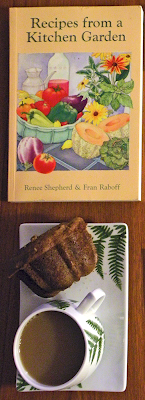 |
| Accompaniments to Garden Planning |
My advice to new gardeners is to start small. It’s easy to
purchase too many things, then become overwhelmed with their planting and
upkeep. Two good rules are to plan where each plant will go first and not buy
more at any one time than you can plant in a weekend. Pick low-water flowers
like California poppy varieties, or veggies that you like that taste
significantly better when home grown. For example, tomatoes off the vine taste
better than just about anything you can buy. Basil can be used throughout the
season with the tomatoes as well as frozen for winter, and is easy to grow, so
is another good choice. Snails and slugs love it too, but you can literally
foil them by growing basil in pots that are wrapped with a strip of self-adhesive copper foil. Lettuce and other greens are also best fresh from the garden,
and it’s easy to grow most, including container-friendly varieties.
 |
| This Year's Seeds...so far |
Renee’s container-friendly seed list includes carrots, celery, eggplant, radishes,
and peppers, plus the usual greens and herbs. You’ll also see not-traditionally
container-friendly flowers like sunflowers, cosmos, dahlias and larkspurs. I’m
going to plant “Super Bush” tomatoes and “Container Zucchini.” Anyone who has
tried growing zucchini in a container can testify that, contrary to popular
belief, zucchini will not grow everywhere.
My “pot” garden will be mostly herbs this year: chives,
French thyme, Italian basil, oregano, sage and parsley, slow-bolt cilantro,
Dukat dill, plus a French perfume lavender. (My marjoram survived the winter.)
For bedding plants I’m adding kneehigh cosmos and flashback calendulas (white
backs “flash” in the breeze) to a bed where other calendulas bloom profusely.
Then, I broke my first rule of gardening and purchased two seeds that I have no
idea where to put (see how easy that is?). But what gardener cook could resist
Pepperbox and Hungarian Breadseed poppies, which in addition to looking lovely
can be dried for culinary poppyseeds?
Feel free to post any seed sources and beginning gardening
information that you might have. I'm also interested in composting information.
Hi, Robin,
ReplyDeleteI'm a square-foot gardener. It satisfies my need for order, and is a great way to use a small garden patch--no rows between plants makes for a higher yield per square foot (or meter). I have just six square feet but each square foot can hold more than you'd imagine. You can also grow up if you're planting vines like squash. Here's a roadplan for the density you can achieve that I found on the web.
Basil: 1/sqft (according to sqft reader Kevin M. Wilson)
Beans: bush-type 9/sqft; pole-type 8/sqft (see special grid)
Beets: 16/sqft
Broccoli: 1/sqft
Cabbage: 1/sqft
Carrots: 16/sqft
Cauliflower: 1/sqft
Celery: 4/sqft (6") (according to sqft reader Doreen Howard)
Chard(Swiss): 4/sqft
Corn: 1/sqft (revised in 2/96 OG to 4/sqft)
Cucumbers: 2/sqft in a row of 4 sqft (6" apart along middle of sqft row)
Daffodils: 36/sqft
Eggplant: 1/sqft
Garlic: 4/sqft (6") (according to several sqft readers. Some say 9/sqft (4"))
Leeks: 9/sqft (see special technique in 2/96 OG)
Lettuce: 4/sqft
Marjoram: 4/sqft (according to sqft reader Kevin M. Wilson)
Muskmelons: 1/sqft (grow in row of 4 squares, on trellis)
Okra: 1-2/sqft (according to reader Sandra Walters)
Onions: 16/sqft
Oregano: 1/4sqft (according to sqft reader Kevin M. Wilson)
Parsley: 4/sqft
Peas: 8/sqft (grow in row of 4 squares on trellis, see special grid)
Peppers: 1/sqft
Potatoes: 1/sqft (see special technique in 2/96 OG)
Radishes: 16/sqft
Savory: 1/sqft (according to sqft reader Kevin M. Wilson)
Scallions: 36/sqft (2") (see special technique in 2/96 OG)
Spinach: 9/sqft
Squash, Summer: vine-type 3/4sqft (see special grid); bush-type 1/3sqft (see special grid) (see also Zucchini's revised spacing)
Squash, Winter: 1/2sqft (see special grid)
Sweet Potatoes: 2/sqft (according to sqft reader John Webster)
Thyme: 4/sqft (according to sqft reader Kevin M. Wilson)
Tomatoes: bush-type: 4/4sqft (see special grid); vine-type 1/sqft (in row of 4 on trellis)
Watermelon: bush-type 1/sqft; vine-type 1/2sqft - both kinds along trellis
Zucchini: 1/sqft
Amazing plan, Rob. Especially useful for urban gardening, which is becoming more popular. Do you use raised beds or till the soil directly?
ReplyDeleteDo you have your crops planned out for this year yet? Would love to photograph your garden later in the season...say in exchange for a bottle of wine? :-)